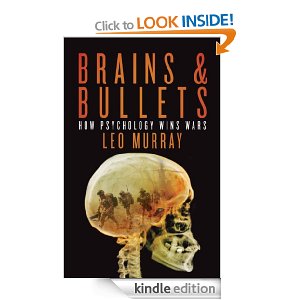Brains & Bullets: How psychology wins wars by Leo Murray
 A crucial curio of warfare is that whilst huge numbers of people get killed in military conflicts, it takes huge numbers of troops and ammunition to kill even a single enemy soldier because very often soldiers hold back. A mixture of factors such as fear, self-preservation, aversion to killing and confusion make them do something other than shoot, and even when they do shoot they often shoot wide.
A crucial curio of warfare is that whilst huge numbers of people get killed in military conflicts, it takes huge numbers of troops and ammunition to kill even a single enemy soldier because very often soldiers hold back. A mixture of factors such as fear, self-preservation, aversion to killing and confusion make them do something other than shoot, and even when they do shoot they often shoot wide.
One of the striking conclusions from the evidence gathered in Leo Murray’s Brains & Bullets is that across different armies, different centuries and different conflicts only a fairly low proportion of troops actually fight at full bloody levels of efficiency. Instead, the battlefield sees large numbers do something else. Even in Afghanistan, infantry assaults usually come down to a few men in a unit who press on with an attack even as their colleagues are finding cover, fretting or otherwise hanging back from following.
Leo Murray seeks to explain what those other activities are and their causes – such as the way many become obsessed with sorting out logistical details rather than advancing, or become so confused they do not know what to do. He does so sympathetically. He clearly has little time for the idea that it’s just a matter of some people not being up to the job.
The search for knowledge is not just one about how to make one side more efficient, for Murray’s main argument is that a better understanding of when soldiers fight well, when they fight badly and when they flee or surrender will help make overcoming an opposition, especially in a conflict such as that in Afghanistan, easier.
He points out, for example, that simply trying to overpower an opponent with force is mistaken. You need to give opponents a chance to flee or surrender, for example by having pauses in artillery bombardment. Hence the effectiveness of tanks combined with infantry. It is not just the combined arms effect, it is also that opposing troops find it much easier to surrender to infantry than to tanks, but it is tanks that often create the fear which leads to a desire to surrender. Combine tanks and infantry together then, and you have a winning combination.
Although he talks less about reducing the number of deaths, winning by having your opponent flee or surrender does also do something to reduce the bloodiness of military conflict.
Understanding the psychological effects on people’s willingness to fight is tricky as they cannot be replicated in training, which in this respect is too far removed from the real thing, and without a clear understanding of their impact the temptation is always to rely on more firepower instead.
As Murray’s book makes clear, it is also a highly controversial area amongst military theorists. He makes an eloquent and well-argued case for the importance of battlefield psychology and the advantages that can come from a better understanding why people do and don’t fight. It may be a controversial case, but it is also a well made one.
Buy Brains & Bullets: How psychology wins wars by Leo Murray here.
Note: a review copy of this book was provided to me by the publisher.
Leave a Reply